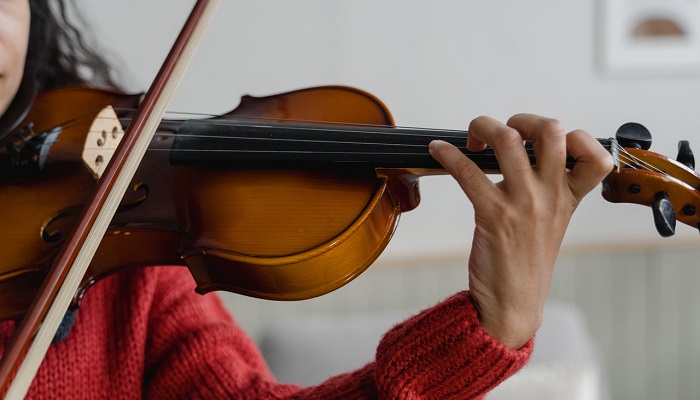Did you know vibrato has been used in music since the 18th century?
The first sign of vibrato ever recorded traces back to Leopold Mozart’s Versuch einer gründlichen Violinschule—a violin instructions textbook that he wrote in 1756.
In the book, the father Mozart described vibrato as ‘the hand movement when holding out a long note.’
Later on, vibrato developed to be a form of singing and a musical tone used mainly by violinists. Read on to find out about vibrato, its history, and types.
What Is Vibrato in Music?
Vibrato is a pulsating tone that goes from slightly above to slightly below the musical pitch. It has an emotional quality, and it’s meant to add an expressive touch to the music.
The word originates from the Italian word vibrare, which translates to vibrate. It describes the vibrating motion of the strings as the musician creates the effect.
In the case of singing, the word ‘vibrato’ describes the motion of the vocal cords.
What Is Vibrato In Singing?
In singing, vibrato occurs when the voice alternates subtly and at lightning speed between two close pitches. As a rule of thumb, the variation in the pitch of musical notes should last less than a semitone, so the vibrato sometimes goes unnoticed due to how fast it’s performed.
Vibrato is deemed as an alternation in the pitch, but it’s also received as a vocal timbre when performed in singing. Some singers describe it as an integral part of the tone, distributed over a group of notes. It’s still a deviation in the pitch, though, no matter what singers or musicians have to say about it.
Although a vibrato only lasts for a few seconds, it has a lot of parameters that change how it sounds. The parameters include the temporal rate—measured in cycles per second—, pitch excursion—otherwise called oscillation—, and amplitude variance.

To perform a vibrato, singers need to learn how to use their diaphragms and vocal cords to produce the desired sound.
Some would argue that vibrato is a natural revelation rather than a practiced technique, but I beg to differ. Their reasoning is that vibrato comes out when the singer’s voice constantly functions relative to the breath flow. So, it’s always there, but it’s revealed when the singer achieves strong vocals.
It’s a matter of opinion, but I believe you need to practice vibrato to get it right. Try to have one of your friends perform a vibrato, and he’ll probably sound like a failed opera singer. It needs practice to be done correctly.
If you want to have an idea of how vibratos are performed, check this video for high note vibratos of famous worldwide artists.
When Did Musicians Start Using Vibrato?
Musicians only started vibrato widely in the 20th century. Although it traces back to the 18th century and the baroque era, the musicians of that period thought using it too often would obscure the harmony of the orchestra.
If you hear records from orchestras of early music, you’ll find the vibrato only used sparingly. On top of that, it’s often only used in one section of an orchestra.
When vibrato was first used, it was deemed a type of musical ornament—shorter than a semitone and used to add an expressive touch.
In addition to that, performing it on a continuous note wasn’t acceptable. It was meant to last for a few mere seconds.
When historians started studying the history of vibrato, they thought it wasn’t used in the baroque era because it has an expressive nature, which goes against the musical works in that era.
However, if that’s true, why wasn’t it used in the 19th century, deemed the Romantic era?
That’s because its rise is associated with the downfall of portamento, the sliding from one note to another when playing the violin.
As the sliding motion became less popular, musicians started replacing it with vibrato to add an expression to the music. That wasn’t until the 20th century.
Types of Vibrato in Music

Although vibrato is an occurrence of a few seconds, there are multiple types of it. Each style is performed differently and uses a different part of your arms. Here’s a roundup of all the types.
Arm Vibrato
An arm vibrato occurs when the impulse for the move comes from the arm. In that case, the violinist’s whole arm acts to move the fingertip, with the hand moving in the process.
It’s known amongst musicians that the arm vibrato offers less control than the other types because the arm is dominant over the wrist and the fingertips.
That’s why it’s not so common among violinists. They only use it sparingly, instead switching to hand and finger vibrato.
Hand Vibrato
The hand vibrato occurs when the violinist moves his hand in a rocking motion to result in the vibration. In that case, the arm stays still without moving, with the wrist being dominant.
Hand vibratos offer more control than arm vibratos because musicians typically have better control in their hands than in their arms. However, it still doesn’t give the level of control that finger vibratos do.
Finger Vibrato
Finger vibrato is the most common type among violinists. It’s a bit similar to the hand vibrato, but the impulse comes from the hand and finger muscles. Meanwhile, it comes from the waving motion of the wrist in hand vibratos.
The thing with finger vibratos is, they need the violinist to possess strength in all of his four fingers, and he needs to be totally in control in every move. Typically, all accomplished string instruments should have full control of their fingers, so that’s not news.
If you only have one strong finger, try to work on it to develop equal strength in the rest. You can go gradually, starting with the first finger, then moving on to the second, and so on.
Slow Vibrato

The slow vibrato doesn’t have to do with the movement of the musician’s arm. Instead, it’s related to the speed of the movement. When the violinist is rocking his finger slowly to produce the vibrato, it’s called a slow vibrato.
Wide Vibrato
A wide vibrato occurs when the violinist rocks his finger wide, making bigger oscillations. The pitch wavers widely, and the vibrato becomes prominent to the receiver.
Narrow Vibrato
The narrow vibrato is the exact opposite of the wide vibrato. It happens when the violinist rocks his finger narrowly, creating minor oscillations. In that case, the pitch only alters slightly, and the ear almost misses the movement.
Wide vibratos sound more expressive; that’s why they’re used often for romantic literature.
How to Develop Your Vibrato Technique
For all musicians, even the experienced ones, it takes a while to develop the vibrato technique. Even if you know how to do it, developing the skill will take a lot out of you.
When performing a hand or a finger vibrato, your fingers should be moving similarly to the motion of rolling dice. Meanwhile, an arm vibrato should feel like you’re shaking your hand.
These motions only sound easy. When implementing them, you’ll find that you have a long journey to master them completely. Developing your vibrato skills will likely turn into a long-term project.
There are three steps you can do to get the hang of your vibratos.
Firstly, you can divide the pitch variation into parameters that make matters simpler for you, like the width and the speed.
You can control your vibrato to be wide or narrow and fast or slow. Then you can start combining the two parameters to create the desired variation.
Secondly, you can play the first part of your piece with a medium-width vibrato. When it’s time to play the same theme again, make the vibrato a bit wider. The music will be more intense then.
Thirdly, you can use different widths and speeds on different parts of the violin. For example, on a high note on the E string, you can play a narrow vibrato. It’ll sound good because that part of the violin is close to the note placement.
Using similar techniques, you’ll be able to master your vibratos, even if the matter takes a long time.
Difference Between Vibrato and Tremolo

A lot of people use the terms tremolo and vibrato interchangeably. However, they’re different effects with different results.
The vibrato is defined as a periodic pitch variation, while tremolo is the fast repetition of the same note, which is more than often a semiquaver. The tremolo is meant to make an audible effect of long notes, especially on instruments that can’t produce long notes on their own, like the guitar.
In practice, most musicians find it hard to achieve a tremolo or a vibrato separately. It’s hard to vary the volume alone without altering the pitch and vice versa.
So, the two practices often occur together, hence the misunderstanding that they’re the same thing.
Now, a lot of musicians achieve both using electronic manipulation. They use an electric guitar for the purpose.







